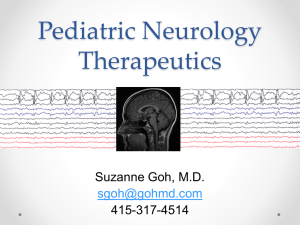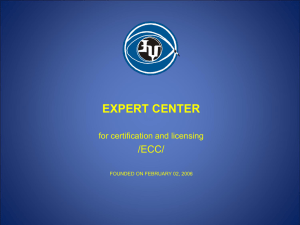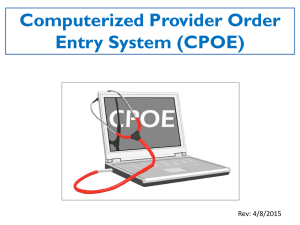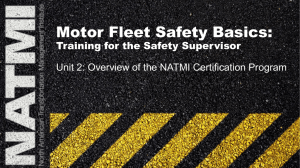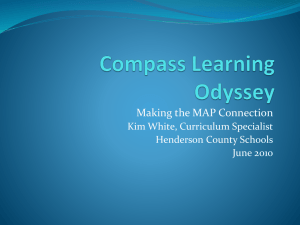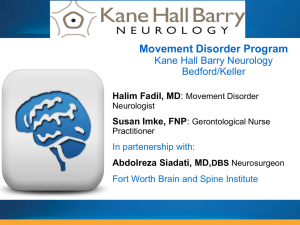Downloadable Presentation
advertisement
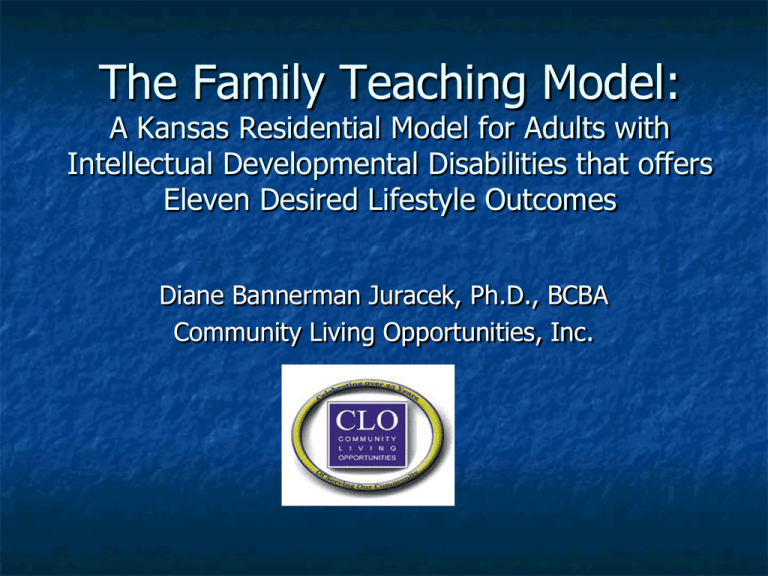
The Family Teaching Model: A Kansas Residential Model for Adults with Intellectual Developmental Disabilities that offers Eleven Desired Lifestyle Outcomes Diane Bannerman Juracek, Ph.D., BCBA Community Living Opportunities, Inc. CLO’s mission is to help adults and children with severe developmental disabilities achieve personally satisfying and fulfilling lifestyles in their own communities. CLO’s Services Residential Options Day Classes Supported Employment Health Care Services: Clinics in Lenexa and Lawrence Applied Behavior Analysis Consultation Positive Behavior Supports Children’s Services Training, Evaluation and Certification Outreach Services Remote Monitoring Midnight Farm Number of Persons Served Across Years Number of Persons Served Across Years *Does Not Include Midnight Farm Only Consumers *Does Not Include Midnight Farm Only Consumers 1983 1985 1988 1990 1993 1995 1996 1997 1998 1999 2000 2001 2002 2003 2004 2005 2006 2007 2008 2009 2010 2011 2012 500 450 450 400 400 350 350 300 300 250 250 200 200 150 150 100 100 50 50 0 0 1983 1985 1988 1990 1993 1995 1996 1997 1998 1999 2000 2001 2002 2003 2004 2005 2006 2007 2008 2009 2010 2011 500 CLO 2012 Demographics 81 homes 214 individuals with intellectual developmental disabilities “Extremely satisfied” or “Satisfied” ratings from 91% of parents/guardians of those we serve 230 adults served in day services in Douglas, Allen, and Johnson Counties Virtual village opens, providing “Homelink” support to promote independence 115 individuals served in CLO wellness clinics and occupational/physical therapy services 330 children served in Children’s Network Early intensive behavioral intervention Family and youth intervention Johnson County Montessori Preschool Northstar Academy Midnight Farm 120 special-needs kids and adults in therapeutic riding 40 special-needs kids in summer camps 750 individuals from community on tours, field trips & special events Building the “Good Life” Timeline of History The Teaching Family Model 1983 CLO 1975 Boys Town Teaching Family Model 1981 DSNWK 2001Tennesee Family Solutions 1970 1st dissemination attempt – not successful 1967 Lonnie and Elaine Phillips/ Mont Wolf 2004 California Community Opportunities Consumer feedback important 1977 Concerned Care Jim Sherman and Jan Sheldon st 1 adaptation for DD population Residential Service Models at Community Living Opportunities, Inc. Group Home Individualized Living 8 housemates Awake shift staff 24 hours a day Funded by Medicaid as a Private Intermediate Care Facilities for Adults with Mental Retardation (ICF/MR) 3 housemates Living in an apartment or home Awake shift staff 24 hours a day Funded by Medicaid Home & Community Based Services (HCBS) waivers for persons diagnosed with Developmental disabilities Residential Service Models at Community Living Opportunities, Inc. 3 Family Teaching Extended Family Teaching or 4 housemates A family teaching couple provides most of the support, lives next door and manages the home Lives with a teacher without disabilities or a teaching family in the same home Both programs funded through Medicaid’s Home and Community-based Waiver for people with DD Family Teaching Model* Components *An adaptation of the Teaching Family Model (Phillips, Phillips, Fixsen, & Wolf, 1974) Family Teachers in family style living environments Individualized daily schedules Teaching new skills Systems for encouraging achievement Positive relationships Opportunities for choice and self determination Ongoing teacher training and consultation Teacher evaluation and certification Family Teaching Model Component # 1 . . . Family Teachers in a Family Style Environment Family Teachers in a Family Style Environment What better model to accomplish this than the Family Teaching Model?! Family Teaching Model Component # 2 . . . Individualized Daily Schedules Thurs Ed Kevin AM Routine* AM Routine *(bath routine) 8:00 AM Meds Meds Meds 8:30 AM Wait for City Bus R&R R&R 7:00 AM 7:30 AM to recycling center Tom Sally goes jogging AM Routine* (Family Teacher) 9:00 AM 10:00 AM Libra 11:00 AM Library ry Kevin’s choice Libra Library ry Tom's Choice 12:00 PM Work @ Recycling Center Lunch (*Lunch routine) Lunch 1:00 PM While John (family teacher) goes to gym Walk High School Track* Walk at High School Track 2:00 PM 3:00 PM 4:00 PM Ed's Choice 4:30 PM Meds Meds/ Dinner Prep Routine* Meds 5:00 PM Dinner/ Chores Dinner/ Chores Dinner/ Chores 6:30 PM Swimming Swimming Swimming 7:00 PM Sally (family teacher) takes Katie (daughter) to Girl Scouts Hobby Choice Check mail and choice of Activity 7:30 PM Snack Snack Routine* Snack 8:00 PM Meds/ PM Routine* Meds/ PM Routine* Meds/ PM Routine* 5:30 PM 6:00 PM Family Teaching Model Component # 3 . . . Teaching New Skills & Quality of Life Planning Continuous Planned and Opportunity Teaching Identification and purposeful teaching of skills: that lead to independence and ability to navigate through their day with less or no assistance that help the person served access highly preferred items, activities, experiences. . . that limit or eliminate any rights issues (privacy, need to have someone assist them in making a phone call) that lead to improved health & safety Behavioral support Eliminates or decreases challenging behavior that inhibits continued progress towards living a good quality of life Reinforcing Desirable Behavior* 1. Initiate Positively a. Use Active Listening Skills (e.g., eye contact, responsive facial expression & voice tone, active listening posture, gestures, verbal and non-verbal encouragement, and reflection) b. Expression of Affection (e.g., smile, greeting, joke, physical contact) 2. Praise and Positive Consequence (descriptive, immediate) Teaching a New Skill* 1. Initiate positively a. Use active listening skills (eye contact, responsive facial expression and voice tone, body posture, and gestures). b. Elicit person’s involvement throughout the interaction c. Expression of affection (e.g., smile, greeting, joke, physical contact) 2. Name appropriate behavior 3. Rationale (e.g., positive consequence of engaging in the appropriate behavior) Ask or give 4. Demonstrate the steps 5. Practice (Use prompts with fading, if necessary) 6. Feedback a. Reinforce: descriptive praise, optional positive consequence b. corrective feedback if needed 7. Practice 8. Feedback a. descriptive praise, optional positive consequence b. corrective feedback if needed 9. Plan when to use the behavior *Some steps may be deleted or shortened depending on the needs and learning style of the individual . Family Teaching Model Component # 4 . . . Systems for Encouraging Achievement Formal or Informal Positive Relationships Motivation Systems – monetary, points, tangibles, etc. . . Behavioral Contracting Premack Principle – eat dinner to get your dessert. . . Staff reinforcement and recognition programs Family Teaching Model Component # 5 . . . Positive Relationships Family Teaching Model Component # 6 . . . Opportunities for Choice and Self Determination What does Self-Determination mean? Making choices freely Having control in areas important to you Being part of decisions that affect you Knowing how to make a choice Feeling free to make a choice Having predictable events in your day/week Family Teaching Model Component # 7 . . . Ongoing Teacher Training and Evaluation The Coaching Process (Sherman J., Harchik A., Strouse, M,) Mini-Inservice Learn about a topic Demonstration Someone shows you how Coaching You practice with shaping Observation & Feedback Systematic, ongoing formal and informal Train to Generalization You practice in a natural setting until you master the skill Reinforce to Maintenance You now use the skill as a matter of course Family Teaching Model Component # 8 . . . Teacher Evaluation & Certification The Community Living Research and Development Project at the University of Kansas Family Teacher Certification Program Providing Certification of Family Teachers employed by Community Living Opportunities, Inc. who exhibit exemplary teaching and implement Community Living Opportunities' Family Teaching Model for Adults with Developmental Disabilities Community Living Opportunities Expected Outcomes for Persons Served Pleasant and Safe Surroundings Observance of Legal and Personal Rights Positive Relationships with Others Living Healthy Lifestyles Opportunities for Choice and Control Effective Learning Opportunities High Level of Participation in Daily Experiences Community Involvement Effective Communication Pleasant Social Environment Satisfied Consumers Family Teaching Model Certification • • • • • • • • • • • • FTM Pre-service Workshop Shadow Training Program Specific Orientation 12 Coaching Lessons 90 Day Evaluation More Coaching Lessons based on Outcome QEs Family Teaching Model Workshop Pre-evaluation meeting for First Private 6 mos. after hire: First Private Evaluation Quality at a Glance Evals Pre-evaluation meeting for Certification Evaluation 12 mos. After hire: Certification Evaluation Certification Celebration and $$ Percent Annual Turnover By Staffing Model 2009 2010 2011 2012 70% 66% 60% 56% 52% 50% 48% 48% 43% 43% 40% 39% 38% 38% 33% 30% 26% 20% 10% 7% 4% 6% 6% 0% EFTs FTM Couples Shift Staff Home Coaches …but there’s more… our latest community living model…VIRTUAL VILLAGE Fewer staff CLO’ Homelink central site monitoring, as needed: audio, video, sensors, devices - in every 2-bedroom apartment Rigorous teaching and progress assessment on independent living skills Daily schedules Classes: problemsolving, roommate conference, home safety…. Jobs Community Inclusion (3rd places) Motivation Point economy system (with daily trips to point exchange store) Self-government – to minimize staff control/increase control and responsibility for the men and women Health ticklers Learning to take medications independently Factors Influencing “Living the Good Life” Fewer number of individuals living in a home in the community Either “Family teachers” providing support or “teaching staff” as opposed to shift-staff Implementation of Family Teaching Model Components family style or roommate living environments Community inclusion Individualized daily schedules Teaching rights, communication, and other skills Systems for encouraging achievement Positive relationships Opportunities for choice and self determination Ongoing teacher training and consultation Teacher evaluation and certification Midnight Farm CLO's Midnight Farm provides year round therapeutic horseback riding lessons to children and adults of all abilities. We have a great time with our summer camps. And any given weekday you can find our day service men and women out working in the greenhouse or creating something in the pottery barn! www.midnight-farm.org Community Living Opportunities Expected Outcomes for Persons Served Pleasant and Safe Surroundings Observance of Legal and Personal Rights Positive Relationships with Others Living Healthy Lifestyles Opportunities for Choice and Control Effective Learning Opportunities High Level of Participation in Daily Experiences Community Involvement Effective Communication Pleasant Social Environment Satisfied Consumers Thank you for your time and interest. Please feel free to contact me for further information: 785-218-9358 Diane Bannerman Juracek, Ph.D, BCBA dianebannermanjuracek@clokansas.org
